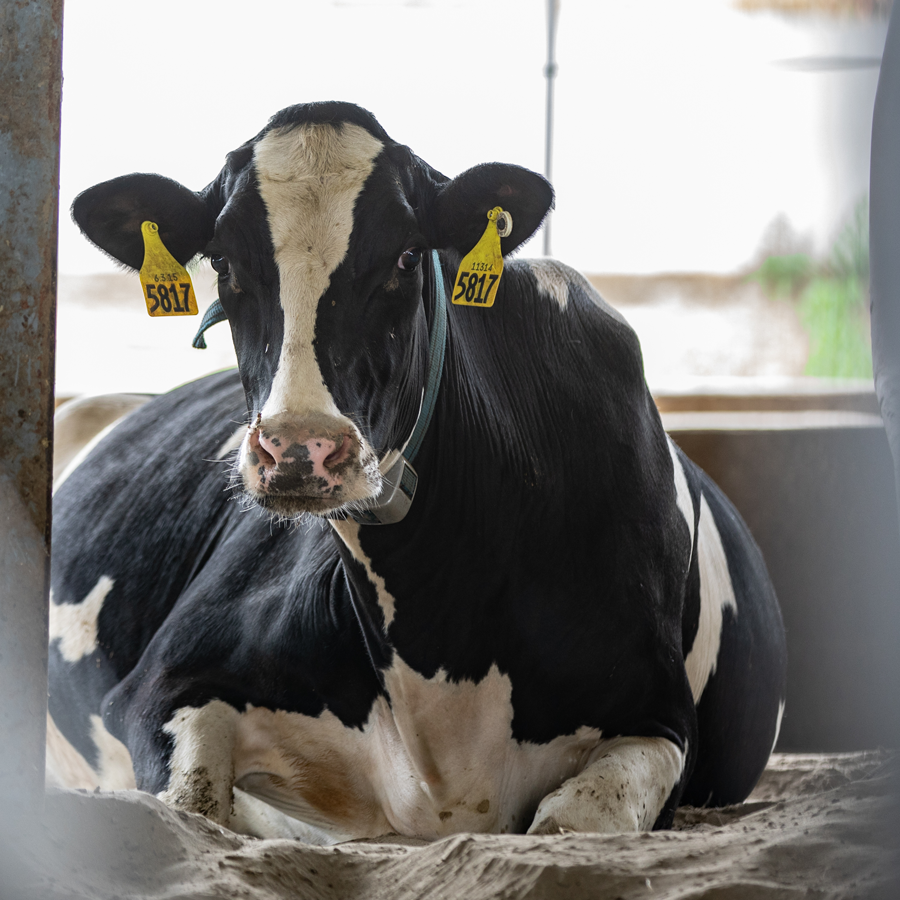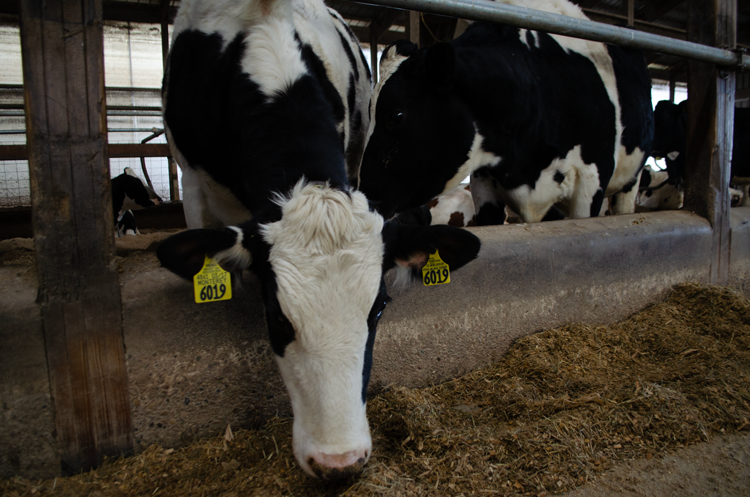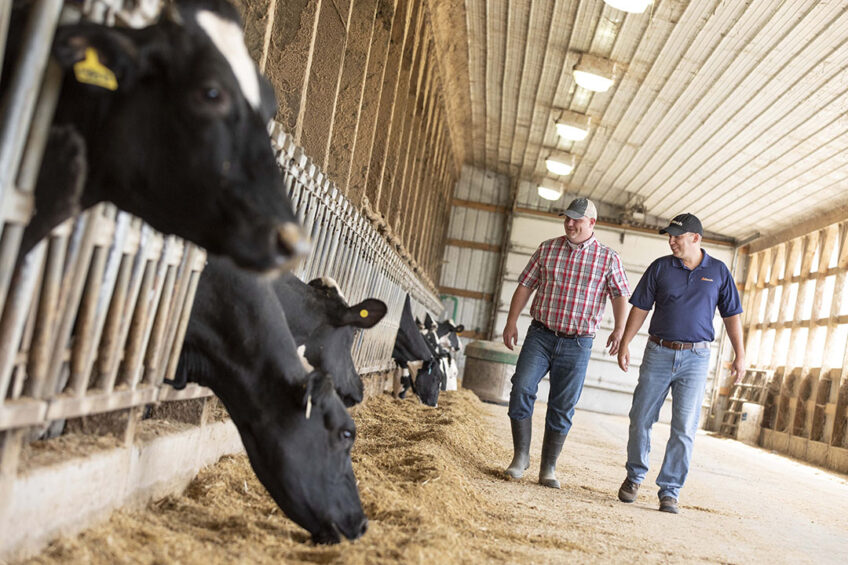Unlock the secrets of optimizing pre-calving body condition in Holstein cows to elevate milk yield and improve energy balance. Are your cows primed for peak production?

Imagine your finest Holstein cows gearing up for another successful lactation. Their physical condition before calving is the key to maximizing milk output and maintaining the best energy balance. As a dairy farmer, every aspect of herd management is crucial. One such specific is your cows’ pre-calving body condition score (BCS). The University of Florida research, which investigates the link between prepartum BCS, dry matter intake (DMI), and energy balance (EB) in multiparous Holstein cows, provides practical insights that can revolutionize herd management. This information empowers you, the dairy farmer, with the knowledge to make informed decisions.
A cow’s postpartum performance depends on her body condition before calving. While too high or too low BCS produces fewer desired effects, a modest BCS connects to higher milk production and energy efficiency. Using data from 427 multiparous cows over 11 trials, this research evaluated how BCS at 21 days before calving influences D MI, EB, and milk output. Offering a whole view of body condition effects, cows were categorized as fat (≥ 4.00), intermediate (3.25–3.75), or skinny (≤ 3.00).
The researchers found that maintaining a reasonable BCS before calving is the key to unlocking the potential for good lactation. This result directly benefits dairy producers, setting the stage for improved performance in the coming months, leading to increased milk output and enhanced herd conditions. This promising finding should inspire optimism and motivation among dairy farmers.
Dairy companies depend on this study to maximize milk output while maintaining herd health. Knowing the subtleties of pre-calving body states helps farmers make better choices that advance sustainability and production.
Mastering Dairy Herd Health: The Importance of Body Condition Scoring
A fundamental management technique in dairy production is the Body Condition Score (BCS). It rates cows’ body fat stores on a scale of 1 to 5. One denotes an emaciated cow; five denotes an obese cow. Understanding dairy cows’ nutritional condition, health, and production depends on this system.
Dry matter intake (DMI), energy balance (EB), reproductive function, and milk output are essential variables that affect BCS. The BCS decides how effectively cows satisfy the metabolic needs of milk production while preserving health during many lactation phases.
The BCS scale is as follows:
- Thin (BCS ≤ 3.00): Underweight cows with visible bones and minimal fat reserves.
- Moderate (BCS = 3.25–3.75): The balanced condition with sufficient fat reserves is ideal for transitioning into lactation.
- Fat (BCS ≥ 4.00): Overweight cows with ample fat reserves may impede feed intake and energy balance, potentially lowering post-calving milk yields.
Maintaining a moderate BCS is crucial for post-calving energy reserves without compromising health. Balanced nutrition and careful monitoring of BCS can result in consistent milk production and healthier cows.
Unveiling Insights: Comprehensive Monitoring and Data Collection in Holstein Cows
The research utilized data from 427 multigravid Holstein cows spread across 11 trials at the University of Florida. These cows were observed from 21 days before calving until 28 days postpartum. Pre- and postpartum daily dry matter intake (DMI) data were maintained; energy balance (EB) was computed by subtracting the net energy consumed by lactating from the energy demand. This method shows how DMI and EB change with bodily condition score (BCS).
Examining Prepartum Dry Matter Intake (DMI) Reveals Critical Insights into Nutritional Management
Analyzing prepartum dry matter intake (DMI) offers critical new perspectives on the nutritional management of dairy cows before calving. This research clarifies the eating patterns and implications of lean, intermediate, and obese cows. With an average daily intake of 9.97 kg, fat cows ate the least prepartum DMI among moderate (11.15 kg) and thin (11.92 kg) cows. Reduced metabolic drive or physical pain as calving approaches might explain this decreased intake in overweight cows.
Consuming 11.15 kg/day, moderate cows demonstrated balanced dietary intake and good energy status. At 11.92 kg/day, thin cows ate the most and helped to offset reduced body reserves. These variances in DMI have essential ramifications. Reduced consumption of fat cows might lead to negative energy balance and metabolic problems postpartum, compromising production and health. Concurrently, moderate consumption by moderately conditioned cows promotes better energy balance, resulting in higher milk output and better lactation.
These results underline the need to maintain a reasonable body condition score for best dry matter intake and good energy balance near calving. This method emphasizes the requirement of constant herd management and monitoring, which may improve milk supply and the general condition of the herd.
Unlocking Postpartum Nutritional Strategies: Ensuring Optimal Dry Matter Intake for Enhanced Dairy Herd Health
Maximizing milk output and herd health depends on dairy producers knowing postpartum DMI. Thin cows (16.09 ± 0.47 kg/d) had the most excellent postpartum DMI, followed by moderate (15.47 ± 0.38 kg/d) and the lowest in obese cows (14.35 ± 0.49 kg/d). This variation in DMI substantially affects cow health and milk output.
Better energy balance resulting from higher DMI postpartum is necessary for excellent milk production and recovery after calving. Thin cows—with the most amazing DMI—usually sustain more milk output with their improved energy balance. On the other hand, poor consumption of fat cows often results in negative energy balance, which influences milk output and causes conditions such as ketosis and fatty liver disease.
Therefore, guaranteeing optimum DMI postpartum goes beyond long-term cow health and immediate milk supply. Before calving, farmers should strive for a modest body condition score (BCS), which will help manage DMI, energy requirements, and milk output. This approach allows a dairy herd to flourish and avoids metabolic problems.
The Crucial Role of Energy Balance: Ensuring Optimal Health and Productivity in Dairy Cows
Managing lactating cows’ dietary requirements depends on energy balance (EB). Their use of energy differs from their requirement of it. A positive EB indicates that a cow consumes more energy than it needs, which causes a weight increase and maybe higher milk production. A negative EB suggests that the cow utilizes more energy than it consumes, which causes weight loss, less milk, and perhaps health problems.
Their health and production depend on an awareness of EB before and after calving. Our investigation revealed that plump cows had a lower EB than either moderate or skinny animals. Meanwhile, intermediate and lean cows had -1.20 and 0.88 Mcal/d, respectively, while prepartum obese cows had -4.16 Mcal/d. Comparatively, to moderate cows, postpartum obese cows had -12.77 Mcal/d; thin cows had -6.14 Mcal/d.
These statistics emphasize maintaining a reasonable bodily condition score (BCS). Moderately, BCS cows produced more milk and improved EB. Dairy producers should monitor and control BCS to guarantee the best health, production, and financial returns.
Maximizing Milk Yield: The Impact of Prepartum Body Condition Score
The profitability of dairy farming depends critically on milk output. Our analysis revealed a strong correlation between milk output and body condition score (BCS) 21 days before calving. Compared to thinner cows with a BCS of 2.5, cows with a moderate BCS of 3.25 to 3.75 generated an extra 6.0 kg of milk daily, producing a 28-day gain of 147 kg. On the other hand, cows with a BCS > 4.00 produced 4.4 kg less milk daily than moderately conditioned cows, causing a 116 kg drop over the same time.
Keeping a modest BCS before calving improves early postpartum milk output. Given that too-thin and obese cows demonstrate lower milk output, this emphasizes the need for BCS control in dairy herd nutrition and health procedures.
Mastering Dairy Herd Health: The Importance of Body Condition Scoring
A key takeaway from our study is the clear conclusion that maintaining a moderate Body Condition Score (BCS) at 21 days before calving is crucial for optimal lactation success. This balance boosts daily and cumulative milk yields and ensures a favorable energy balance before and after calving. A balanced nutritional state fosters long-term health and productivity in your dairy herd.
For farmers aiming to maximize their herd’s potential, here are some practical tips to achieve and maintain that optimal BCS:
- Regular Monitoring: Score your cows’ body condition regularly. Consistent assessment allows timely adjustments to feeding, preventing cows from becoming too thin or fat.
- Balanced Nutrition: Provide a diet rich in energy, protein, vitamins, and minerals. Tailor the feed plan to the specific stages and production levels to prevent nutritional imbalances.
- Feed Quality: Use high-quality forages and grains. Quality feed boosts intake and improves diet energy density, aiding BCS management.
- Adjust Feeding During Transition: Focus on the transition period (three weeks before and after calving). Adjust feeding strategies to support energy intake and ease the shift into lactation.
- Health Management: Schedule regular veterinary check-ups. Health issues can affect appetite and nutrient absorption, emphasizing the need for disease prevention and early detection.
- Stress Reduction: Minimize overcrowding, sudden dietary changes, and extreme weather conditions. Stress impacts feed intake and energy balance, affecting BCS.
By following these practical tips, farmers can manage their dairy herds effectively, ensuring cows maintain a moderate BCS. This maximizes milk production and supports overall herd health and well-being.
The Bottom Line
A moderate body condition score (BCS) 21 days before calving is essential for multiparous Holstein cows’ best dry matter intake (DMI) and energy balance. The research emphasizes that cows with a moderate BCS outperform those under-conditioned or over-conditioned, producing more excellent nutrition and milk output.
Dairy producers should prioritize BCS monitoring to guarantee adequate lactation and general herd health. Investing in BCS evaluation improves personal cow performance and dairy enterprise profitability and output. Good management of a dairy herd depends on a modest BCS.
Key Takeaways:
- Cows with a moderate BCS at 21 days before calving demonstrate the most balanced dry matter intake (DMI) and energy balance (EB) prepartum and postpartum.
- Over-conditioned (fat) cows tend to have lower DMI and EB, negatively impacting their milk production and overall health.
- Thin cows show higher DMI but may not sustain optimal energy balance, affecting their lactation performance.
- Maintaining a moderate BCS of around 3.25-3.75 is crucial, as it is directly linked to higher daily and cumulative milk yield.
- Monitoring and adjusting prepartum nutrition based on BCS can lead to significant improvements in postpartum milk production and cow health.
Summary:
The University of Florida’s study on the relationship between pre-calving body condition score (BCS), dry matter intake (DMI), and energy balance (EB) in multiparous Holstein cows provides practical insights for dairy herd management. A modest BCS leads to higher milk production and energy efficiency, while a moderate BCS is crucial for good lactation. The study evaluated the impact of BCS on DMI, EB, and milk output using data from 427 multiparous cows over 11 trials. Thin cows have the most excellent postpartum DMI, followed by moderate cows (15.47 ± 0.38 kg/d), and the lowest in obese cows (14.35 ± 0.49 kg/d). Better energy balance is necessary for excellent milk production and recovery after calving. Farmers should strive for a modest BCS before calving to manage DMI, energy requirements, and milk output.













